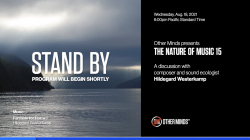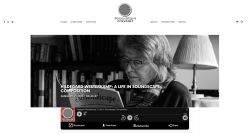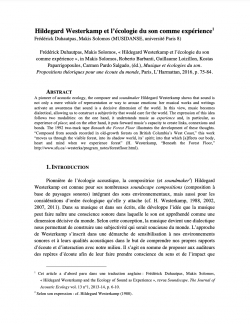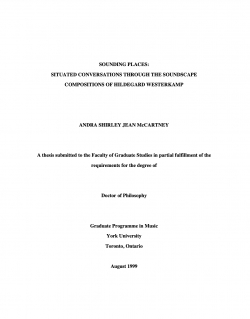Bauhaus and Soundscape Studies - Exploring Connections and Differences

Type
Publication
Authors
Westerkamp ( Hildegard Westerkamp )
Category
Article
[ Browse Items ]
Publication Year
1994
Abstract
Aspects of this text were originally presented in two lectures at the Symposium
From Bauhaus to Soundscape
Goethe Institut Tokyo, October 1994, revised March 2002
"From the very start of my work with R. Murray Schafer and the World Soundscape Project (WSP) in the Seventies it was clear that Bauhaus had had a strong influence on how Soundscape Studies emerged as a field of study and how it was defined. Schafer wrote that
The most important revolution in aesthetic education in the twentieth century was that accomplished by the Bauhaus. Many famous painters taught at the Bauhaus, but the students did not become famous painters, for the purpose of the school was different. By bringing together the fine arts and the industrial crafts, the Bauhaus invented the whole new subject of industrial design. 1
Two aspects attracted Schafer to Bauhaus: the interdisciplinary nature of its training and design practice, as well as the connection that was made between craftsmanship and artistic production, functionalism and creativity. In our work as the WSP - most of us were composers and musicians - we made similar connections: the composer was perceived not only as the acoustic designer of musical sound in a composition, but also and most importantly as an acoustic designer of daily life. As a result we studied the many aspects of sound and applied it to real life situations. Rather than staying marginalized by producing inaccessible and abstract art music to small exclusive audiences, we thought of the composer as a valuable contributor towards dealing with issues of soundscape. Composers could become the socially conscious, sonic-architects or acoustic designers of our cities, buildings, and villages. It was precisely this - the vision of the artist/composer as a crafts person, as someone trained in all disciplines of sound, and as someone entirely connected to and useful in the real working world - that attracted me to the WSP. And Schafer's vision went further:
An equivalent revolution is now called for among the various fields of sonic studies. The revolution will consist of a unification of those disciplines concerned with the science of sound and those concerned with the art of sound. The result will be the development of the interdisciplines acoustic ecology and acoustic design. 2
In other words, not only did we as composers familiarize ourselves with the various scientific aspects of sound, but we also saw it as our task to bring together the various professions that were already dealing with acoustics, sound and noise. To date - 25/30 years later - this vision of unification of disciplines that Schafer presents in the above quote has hardly taken root. Like the original members of the WSP, most people who are engaged in the field of soundscape studies or acoustic ecology nowadays are also composers, musicians, radio artists, and so on. The odd architect, geographer, town planner, psychologist, acoustical engineer, audiologist and others have indeed become involved. But these usually are exceptions, they are scholars and professionals who have dared to break the boundaries of their own specialization and want to move towards a more interdisciplinary or multi-disciplinary approach to sound..."
From Bauhaus to Soundscape
Goethe Institut Tokyo, October 1994, revised March 2002
"From the very start of my work with R. Murray Schafer and the World Soundscape Project (WSP) in the Seventies it was clear that Bauhaus had had a strong influence on how Soundscape Studies emerged as a field of study and how it was defined. Schafer wrote that
The most important revolution in aesthetic education in the twentieth century was that accomplished by the Bauhaus. Many famous painters taught at the Bauhaus, but the students did not become famous painters, for the purpose of the school was different. By bringing together the fine arts and the industrial crafts, the Bauhaus invented the whole new subject of industrial design. 1
Two aspects attracted Schafer to Bauhaus: the interdisciplinary nature of its training and design practice, as well as the connection that was made between craftsmanship and artistic production, functionalism and creativity. In our work as the WSP - most of us were composers and musicians - we made similar connections: the composer was perceived not only as the acoustic designer of musical sound in a composition, but also and most importantly as an acoustic designer of daily life. As a result we studied the many aspects of sound and applied it to real life situations. Rather than staying marginalized by producing inaccessible and abstract art music to small exclusive audiences, we thought of the composer as a valuable contributor towards dealing with issues of soundscape. Composers could become the socially conscious, sonic-architects or acoustic designers of our cities, buildings, and villages. It was precisely this - the vision of the artist/composer as a crafts person, as someone trained in all disciplines of sound, and as someone entirely connected to and useful in the real working world - that attracted me to the WSP. And Schafer's vision went further:
An equivalent revolution is now called for among the various fields of sonic studies. The revolution will consist of a unification of those disciplines concerned with the science of sound and those concerned with the art of sound. The result will be the development of the interdisciplines acoustic ecology and acoustic design. 2
In other words, not only did we as composers familiarize ourselves with the various scientific aspects of sound, but we also saw it as our task to bring together the various professions that were already dealing with acoustics, sound and noise. To date - 25/30 years later - this vision of unification of disciplines that Schafer presents in the above quote has hardly taken root. Like the original members of the WSP, most people who are engaged in the field of soundscape studies or acoustic ecology nowadays are also composers, musicians, radio artists, and so on. The odd architect, geographer, town planner, psychologist, acoustical engineer, audiologist and others have indeed become involved. But these usually are exceptions, they are scholars and professionals who have dared to break the boundaries of their own specialization and want to move towards a more interdisciplinary or multi-disciplinary approach to sound..."
Description
https://www.hildegardwesterkamp.ca/writings/writingsby/?post_id=16&title=%E2%80%8Bbauhaus-and-soundscape-studies---exploring-connections-and-differences-
Number of Copies
1
| Library | Accession No | Call No | Copy No | Edition | Location | Availability |
|---|---|---|---|---|---|---|
| Main | 334 | 1 | Yes |




